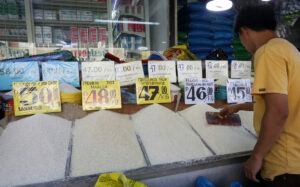




Monthly Economic Update: One for the road
 DOWNLOAD
DOWNLOAD

Inflation Update: Still low, still slow
 DOWNLOAD
DOWNLOAD

Philippines Trade Update: Exports momentum continues
 DOWNLOAD
DOWNLOAD


Rice retailers set to receive subsidies

The government will extend financial assistance to retailers affected by price ceilings on rice, President Ferdinand R. Marcos, Jr. said on Monday.
The goal is to compensate rice retailers who are expected to lose income due to the price ceilings on regular and well-milled rice, he said in a speech before flying to Indonesia for a summit of Southeast Asian leaders.
The President said the Agriculture and Trade agencies are now preparing the list of rice retailers and their associations, as well as identify the amount of assistance needed to compensate them for their losses.
An executive order setting a nationwide price ceiling on rice will take effect today, September 5. The order mandates a maximum price of PHP 41 per kilo for regular milled rice and PHP 45 for well-milled rice, as part of government efforts to protect consumers amid a surge in the food staple’s retail prices.
“We’ll have to consider how authorities can first afford to do this and how they will fund the subsidy,” ING Bank N.V. Manila Senior Economist Nicholas Antonio T. Mapa said in a Viber message.
He said the government needs to ensure that there will be “a clear method for all retailers to enjoy the support and not just a few.”
“If not all retailers receive support, we may see inefficiencies surface anew,” he said.
House Speaker Ferdinand Martin G. Romualdez, Mr. Marcos’ cousin, said he had instructed the Committee on Appropriations to look for ways to allocate PHP 2 billion for the subsidy program.
“Our goal is to ensure that we can extend assistance to rice retailers who may be affected by this rice price ceiling, as it is a directive from our President aimed at protecting consumers,” he said.
Ako Bicol Party-list Rep. Elizaldy “Zaldy” Co, chairman of the House Appropriations panel, said the committee would work with the Department of Budget and Management to expedite the release of the PHP 2 billion.
However, the move to provide subsidies is unsustainable given that there are thousands of small retailers nationwide, said Enrico P. Villanueva, a senior lecturer at the University of the Philippines Los Baños.
“It is inefficient, hard to implement and unsustainable,” he said via Messenger chat, noting that the government should instead lower rice tariffs.
In his departure speech, Mr. Marcos said the Department of Agriculture and other agencies have found no acceptable reasons behind the spike in rice prices, which are now above PHP 50 per kilogram.
He said the government does not want to intervene in the market as much as possible but has been forced to impose price ceilings on rice due to alleged smugglers and hoarders’ disruption of the basic law of supply and demand.
“The people have suffered already, that’s why the government has been forced to impose price controls,” he said in Filipino. “This is a temporary measure; the rice supply will be coming in the second week of September.”
Social Welfare Secretary Rexlon T. Gatchalian described the price control as “a temporary stop-gap measure.”
“We don’t expect it to be long,” he told reporters on the sidelines of the departure ceremony for Mr. Marcos.
He said the department would implement a sustainable livelihood program for small-scale rice retailers.
The imposition of price control has been heavily criticized by economists, who said the order could limit the supply of the food staple and lead to black-market trading.
They also said traders might hesitate to buy rice from farmers, who will be left with no choice but to lower farmgate prices.
Mr. Marcos met with officials of the Trade department and other agencies hours before his departure speech.
The Presidential Communications Office said that aside from assistance, loan programs for rice retailers were also considered during the meeting.
“Instead of using the limited resources, we have to modernize our agricultural production and distribution system, we are going to use funds to give loans to retailers who themselves are embroiled in a messy and inefficient distribution system,” said Leonardo A. Lanzona, who teaches economics at the Ateneo de Manila University.
“For what purpose? To save face after making campaign promises to produce rice at PHP 20 per kilo?” he asked.
The economist reiterated his call for the government to revoke the price control order and “instead, develop systems and mechanisms to reduce transaction costs by matching the needs of farmers and the demands of consumers.”
Earlier, Mr. Lanzona said that if the government sees hoarding and smuggling as the key drivers of the surge in rice prices, it should encourage more players to enter the market, such as micro, small and medium enterprises and farmers, who can transact directly with consumers.
The Palace said the government is also eyeing logistics support “like providing government transportation for transferring sacks of rice from traders to retailers/wholesalers.”
It said programs that could link local rice farmers with supermarket chains and other retailers were also discussed during the Monday meeting.
In a separate statement, the Palace said Trade Secretary Alfredo E. Pascual has ordered the creation of a special task force that will profile and validate the list of rice retailers.
The task force’s official list “shall be the basis for the distribution of financial aid by the Department of Social Welfare and Development as early as next week,” Trade Assistant Secretary Teodoro Uvero said.
He said the task force will conduct visits in warehouses in various locations to ensure that there is enough supply and discourage hoarding.
“The task force will ensure that consumers are protected and retailers will receive the assistance they need as the executive order takes effect,” he added. — Kyle Aristophere T. Atienza
This article originally appeared on bworldonline.com





 By BusinessWorld
By BusinessWorld